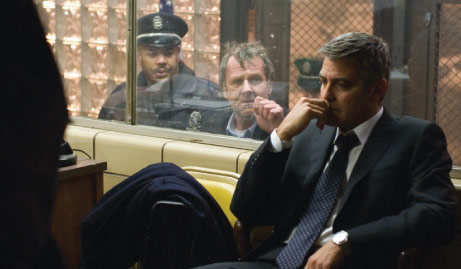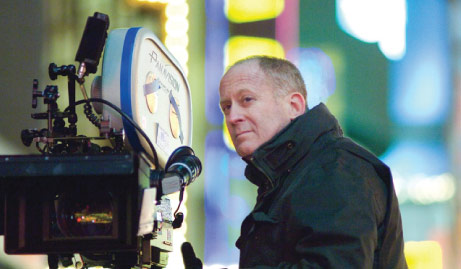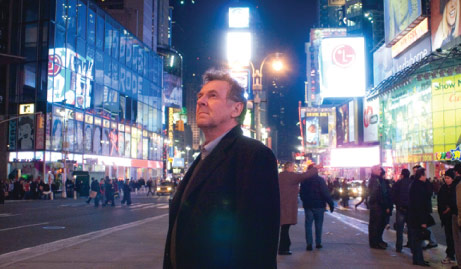 |
 |
 |
 |
 |
|
|
 |
 |
|

|

|

|
SEPTEMBER CONTENT:
|
 |
|
 |
MICHAEL CLAYTON, DP Robert Elswit, ASC
By David Geffner
MR. WOODCOCK, DP Tami Reiker, ASC
By Bob Fisher
FLIGHT OF THE CONCHORDS, DP Patrick Alexander Stewart
By Elina Shatkin
PRESIDENT'S LETTER
by Steven Poster, ASC
CREW VIEW, 1st Assistant Tim Arasheben
By Bonnie Goldberg
|
TIPS & TOOLS, By Bonnie Goldberg
OPERATING TIPS
By Bill Hines and Jack Messitt, SOC
CLIP ART, Carravagio
DP Vittorio Storaro, ASC, AIC
By Robert Allen
TRIBUTE TO LASZLO KOVACS, ASC
By Bob Fisher
UNDER THE INFLUENCE
Compiled by Pauline Rogers |
|
 |
 |
 |
|
 |
 |
 |
ROBERT ELSWIT, ASC CHANNELS THE '70S LOOK
By David Geffner
Photos by Myles Aronowitz/Warner Bros. Pictures |
| |
 |
| |
When cinematographer Robert Elswit walks into a Studio City Starbucks to talk about his most recent film, Michael Clayton, the vibe can best be described as “back to the future.” Elswit, who cut his teeth at Industrial Light & Magic, under special effects masters like Dennis Muren, ASC and Ken Ralston, plunks down a Leica M6 digital rangefinder (a dead ringer for the legendary 35mm Leica that changed photo journalism) and talks about using it as a light meter for Clayton’s New York City shoot. “I’d set my shutter at a 50th of a second, my ASA at 100, and snap a digital still just before we rolled,” he recalls. “It helped me check interior/exterior color balances, and exterior backgrounds when I had to create a sodium vapor look. The dynamic range isn’t as broad as my negative, of course. But the digital image gives you a feel for what the lighting looks like at full exposure.”
New York movies of the 1970’s, most notably Klute (shot by Gordon Willis, ASC) and Network (shot by Owen Roizman, ASC), were the foundations of Michael Clayton’s palette, so Elswit’s “back to the future” approach was a snug fit. The DP shot in anamorphic (without filtration or special processing) on Kodak Vision 5217 and 5218, and finished in a 2K digital suite at Technicolor with the much-admired colorist Stephen Nakamura. The film’s bold contrast ratios pay homage to classics like The French Connection (also shot by Roizman), and The Pope of Greenwich Village (shot by John Bailey, ASC), while the Panavision C series lenses (developed decades ago, and modernized by Dan Sasaki) softened resolution and increased flaring (like 1970’s era films), while still providing a clean, grainless negative. Elswit, and his first-time director Tony Gilroy, culled from New York anamorphic classics, while adding new school touches like invisible Steadicam and digital scaling. “Those films had minimal camera movement and exploited image size changes,” says Elswit, “bouncing in from very wide to very close, for example, to highlight their graphic qualities. Rather than using a standard master and coverage, the shots all stand on their own and that’s what we tried to emulate. Tony even looked through the camera, and screened dailies (digitally projected) every day, both of which seem like rarities for most directors these days.”
When we first meet Michael Clayton, a “fixer,” who papers over the indiscretions of corporate clients for Manhattan law firm, Kenner, Bach, & Ledeen, he’s at an after-hours card parlor in Chinatown. A phone call orders him up to Westchester to bail out a client who just committed a hit-and-run fatality. The weary attorney races through the area’s rural back roads in emotional distress: divorced, and heavily in debt from a failed restaurant investment, he’s burnt out on cleaning up the personal messes of CEOs for his boss, Marty Bach (Sydney Pollack). When he abruptly stops and scampers up a hill to watch the dawn rising behind a trio of wild horses, his BMW sedan inexplicably explodes in a tower of flames. What follows is a four-day flashback leading up to the explosion, the heart of which concerns his firm’s main cash cow client, U/North, a farming conglomerate about to pay out a low-ball settlement in a multi-billion dollar class action suit.
Clayton is sent to muzzle his firm’s brilliant, but deranged senior litigator, Arthur Edens (Tom Wilkinson), who has uncovered the true extent of U/North’s crimes, but is stuck in an Omaha jail for stripping naked during a deposition! U/North’s ruthless chief counsel, Karen Crowder (Tilda Swinton), who will do anything, including sanctioning murder, to protect her firm’s interests, plays cat and mouse with Clayton, who picks up the trail where Arthur Edens leaves off. What unites Michael Clayton with 1970’s era wide-screen masterpieces are its richly detailed blacks and shadows, and a cool blue-gray color palette that cloaks Manhattan in a permanent hangover (much like the story’s worn-out title character). However, what gives the film its own sense of timelessness is the searing sunshine that invades Clayton’s world, despite it being winter in New York. “We had planned for rainy, overcast weather,” Elswit recalls, “which would have kept the window highlights coming in through the high-rise balanced, and our day exteriors flat and washy, just like the ‘70’s films we were drawing from. Instead we got bright sunshine every day, and that changed the look of the movie.” Elswit embraced the extreme contrast swings in both the night and day exteriors. “I didn’t want to use fill light,” he explains. “I wanted to let the shadows fall off naturally.” The DP cites a scene early on when Clayton is being squeezed for his debts inside the restaurant he has lost to his creditors. “We wanted a natural feeling, and not lighting that was imposed,” Elswit notes. “I pushed some |
 |
 |
 |
|
18Ks through the windows and used the bright sunshine to my advantage. The 5217 allowed for a very big negative and the range in the shadows turned out great.”
Elswit describes Michael Clayton’s most challenging scene as a chance daytime meeting between Edens and Clayton in a Tribeca alleyway after the star litigator has been released from jail. Carrying a huge bag of French baguettes (for no apparent reason), Edens is surprised by Clayton, who has been combing the city in an attempt to bring his friend back into the fold. “We had done some scenes in Goodnight and Good Luck using multiple cameras where George wanted the actors not to worry about matching or overlapping,” Elswit recalls. “Tony used the same method in the alley; George has a lot of dialogue and we didn’t want to exhaust him with too many takes. Using multiple cameras was not the problem—I could use long lenses, and hide the cameras from being in each other’s sightlines. But lighting both actors was tough without compromising one of the angles.”
Ultimately, the location worked in Elswit’s favor. He selected an alley that was easily controlled, like a stage set, with high buildings on either side, and constant, open shade to the ambient sunlight. Backgrounds were tricky to control the entire day, but the real challenge was lighting each actor’s face in a subtle and effective way. “We did two mediums and two close-ups with the actors coming to a fixed point mid-way through the scene across from each other,” Elswit continues. “I ended up putting two 6K Pars between them and bouncing the light into pieces of foam core. I had to block each 6K Par off the other actor, so each unit only worked in one direction. The result was a strong 3/4 front-light that was mainly sourced by the sunshine filtering in from the sides and above. If we had shot the scene in LA on a stage we would have built a rig, but it was on location in New York City without much time or money, so it was a long and challenging day.” The climax of Michael Clayton, while understated, registers a strong emotional sting. Karen Crowder has just made her settlement pitch to U/North’s board of directors in the ballroom of the Hilton Hotel, on Sixth Avenue. When she walks out to the lobby, she confronts Clayton, who she believes has died in the explosion she engineered. The vast lobby where the two lawyers square off is lined with floor to ceiling windows, but offered little daylight due to vertical pillars running the length of each window. “I had to create something that would last all day and the only question was whether to go HMI or tungsten,” says Elswit. “We ended up using twelve 80-foot scissors lifts with 20Ks and full grid on the windows, so tungsten seemed like the right call.” Scanning out to a digital negative proved to be a safety net with the scene’s blown-out highlights, and it allowed Elswit to change the density of each window individually. The scene also features one of the few motivated camera moves in the entire film. Karen Crowder offers Michael Clayton a $10 million bribe not to reveal the memorandum Arthur Edens had uncovered that proved U/North’s products were toxic. Clayton records the bribe on tape, and then strides off through the lobby, |
| |
|
 |
| |
|
as Crowder collapses on the carpet in resignation. As Clayton moves into foreground, the camera pulls back to reveal a small army of NYPD officers converging on Crowder. The dark uniforms create an extreme contrast to the bright white daylight pouring in through the room’s many windows, and the shot becomes a dramatic microcosm for the entire story.
While this scene is a jaw-dropper, the car explosion that bookends the story is the most arresting moment; and the second time around we see it from the perspective of the killers who planted the bomb. Gilroy, who was a screenwriter on the three Bourne blockbusters, shot virtually every word of his script for Michael Clayton, and he designed the bomb to play as a complete surprise. “Tony wanted George sharp in the foreground, and the car to blow up out-of-focus down at the bottom of the hill,” says Elswit. “It had to be done in elements because the horses could not be present during the explosion. We shot them against a green screen at the same location.” Gilroy also insisted the distances not be cheated when the killers see the explosion from the other side of the woods. As Elswit explains: “the pyro team set up another explosion in the exact same spot. You can see the frame suddenly sharpen in the middle at the point of light of the explosion.
Maintaining focus with an anamorphic lens can be difficult, and our focus puller, Baz Idoine, whom I worked with on Syriana and Good Night and Good Luck, is one of the very best. We didn’t have to digitally sharpen a single shot in Michael Clayton, and that includes some of the long lens Steadicam work our operator, Scott Sakamoto, did in Chinatown when George is walking down the street at night toward his car.”
In a movie filled with strong, graphic frames, each one capable of being a potent photographic still, it’s no surprise that Elswit also shot 35mm color slides in preparing each of his locations. “I’d bring a light box to the set and put up the slides to give me |
| |
|
 |
a color reference for how the location is supposed to look at the time of day when the scene takes place,” describes Elswit. Matching color temperatures in office suites filled with fluorescent lights and east and west facing windows was a key concern. The production had the use of an empty high-rise floor to portray Kenner, Bach & Ledeen’s headquarters, and Elswit had all the UV dimming film stripped off the windows. The DP says the UV treatments cut out 2-3 stops of light off the backgrounds for night interiors, and add magenta during the day. “Even without the UV film on the windows, I still had to add ND 6 in Clayton’s office, for example, when he’s on the phone and the sun is streaming in,” he says. “We had overhead fluorescents, which meant adding blue, taking out green, and paying close attention to matching the outside light. The exception was Eden’s Tribeca apartment, which had no treatments at all on the windows because it’s a 100 year-old industrial loft!” Elswit says he signed on to Michael Clayton because it offered up the chance to “channel the work” of the DPs who made the biggest imprint on his career. “The movies that came out of New York City from 1965 to 1985, were, to me, the creative peak in American cinema,” adds Elswit, “and I wanted to find my way back to those movies, led by the likes of Gordon Willis and Owen Roizman, that I saw in film school.” Rather than today’s steady diet of over-the-top action and digital effects, Michael Clayton is a thriller played out through psychology and behavior, and the desperation of the titular character is palpable. “Tony was driven to let the mechanics of the story show through,” concludes Elswit, “and that’s risky for a star-driven movie made by a studio. I don’t think I would have wanted to make the $7 million version [of Michael Clayton], given the lighting challenges and locations. But the $60 million version would have been overblown and lacking surprise. The movie we made walks a delicate line, and that’s what made it so special.” |
|
 |
|
|
 |
|
|
 |